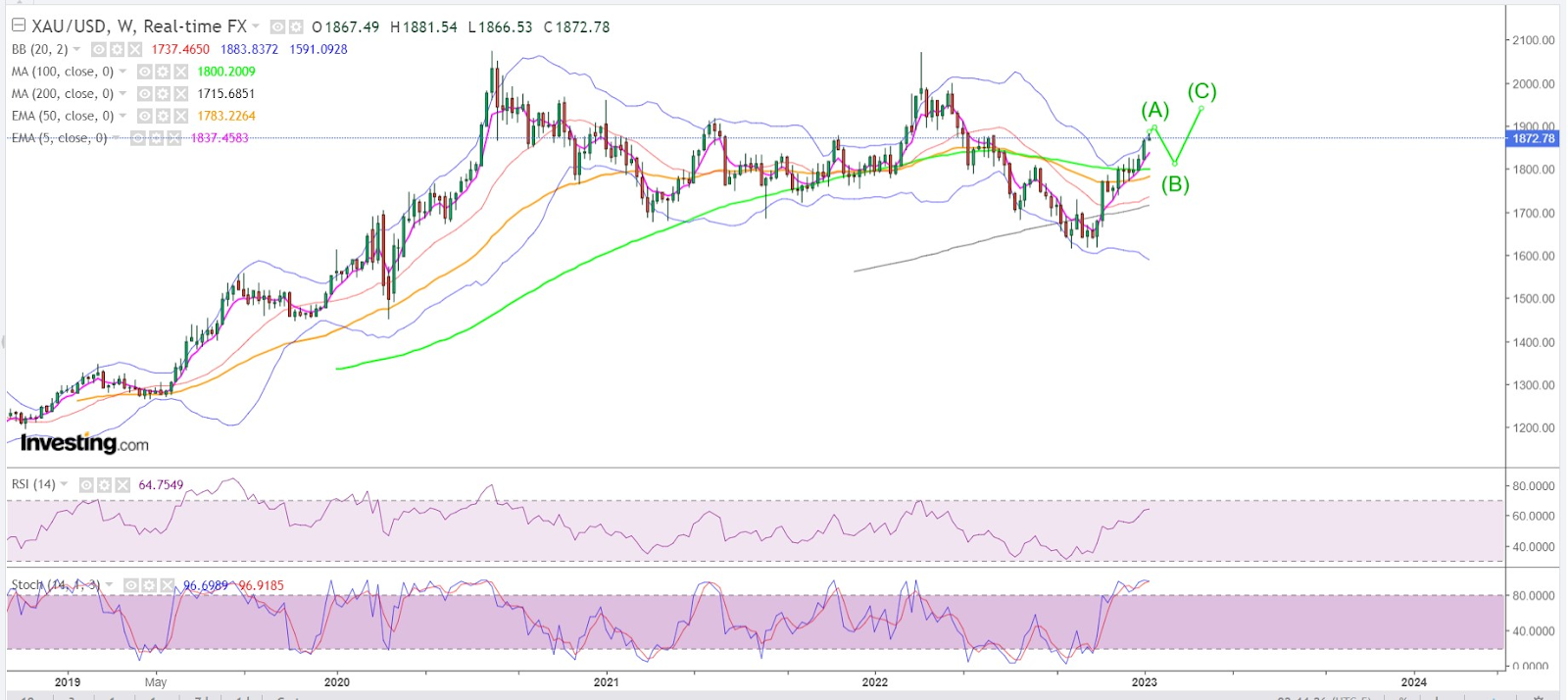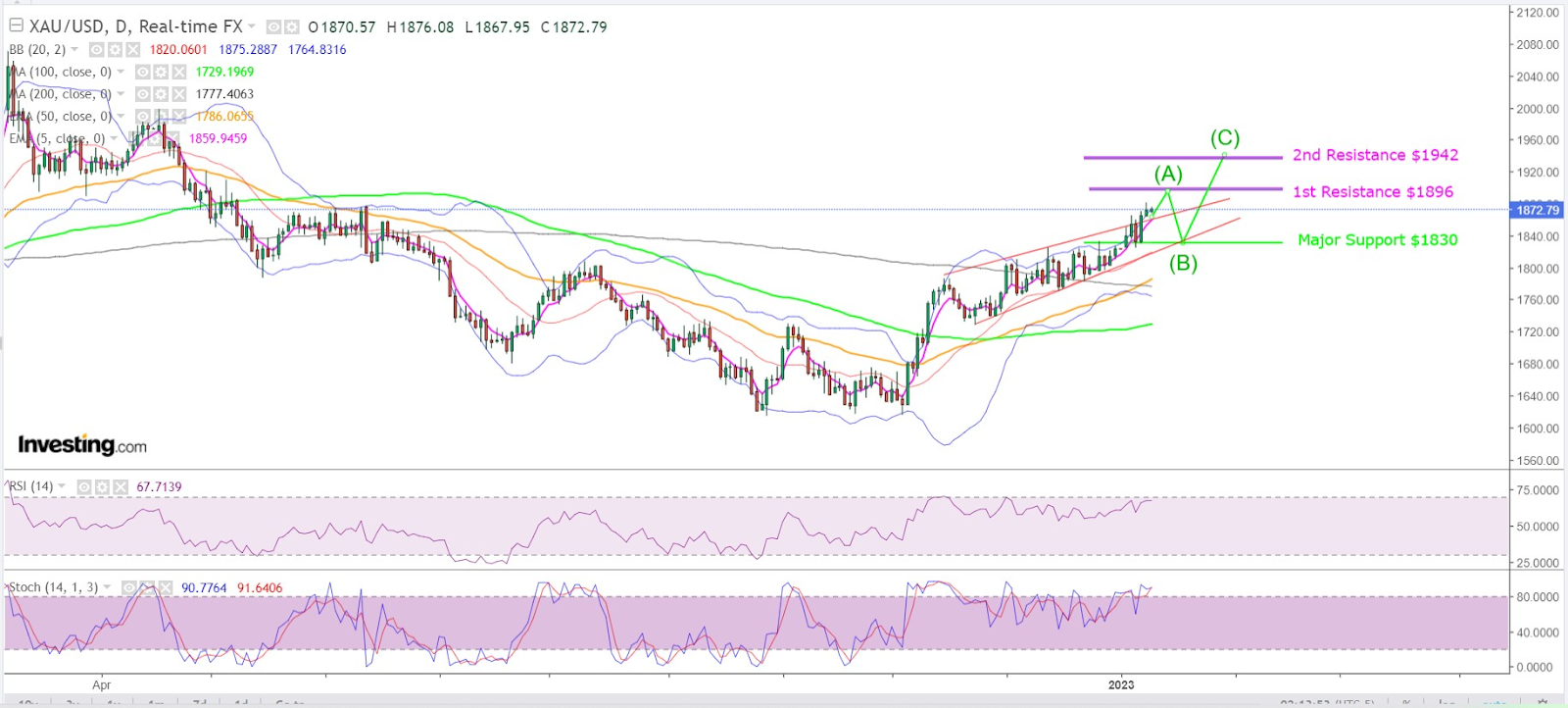- Gold has only slid thrice in 15 sessions, having one of its most bullish phases in a year
- Test for $1,900 will be contingent on Dec U.S. CPI coming at 6.5% and lower
- Other catalysts would be Dollar Index under 103, Treasury yields below 3.11
Gold had only three loss-making days in the last 15, making it the most bullish period for the yellow metal since a year ago, before it ultimately edged towards April’s near-record pricing.
The yellow metal could again be poised for such lofty times, provided it passes its first test with this Thursday’s U.S. Consumer Price Index, or CPI, reading for December.
The CPI grew at a rate of 7.1% during the year to November, slowing from a four-decade high of 9.1% during the 12 months to June.
It is expected to have slowed even further to 6.5% during the year to December, according to the consensus of Wall Street and economists polled by the media. In line with those expectations, the Federal Reserve is eyeing a 25-bp rate hike for its policy meeting concluding on Feb. 1, a climb down from the 50-bp hike in December and four back-to-back 75-bp increases between June and November.
The odds are pretty short for the Fed to do this, with Investing.com’s Fed Rate Monitor tool assigning an 84.4% probability for a 25-bp hike in February. The last time the central bank had such a low rate hike was in March 2022, when it kicked off its series of rate hikes to curb runaway inflation in the aftermath of the coronavirus pandemic that broke out in 2020. Charts by SKCharting.com, with data powered by Investing.com
Charts by SKCharting.com, with data powered by Investing.com
While gold prices have been bubbling the past three months in anticipation of the lower Fed pivot on rates — rallying some $235 an ounce, or 14%, since November — what would really send the yellow metal flying and its nemesis the dollar into a freefall would first be a CPI reading below 6.5% for the year to December.
The Dollar Index that pits the U.S. currency against six other majors has held above the critical 103 support despite a slowdown in two major inflation components of late: U.S. jobs numbers measured by nonfarm payrolls and the services sector benchmarked to the Purchasing Managers Index, or PMI.
Nonfarm payrolls fell by 33,000 last month, while the Services PMI was at its lowest since March 2020, with a reading of 49.6 versus a forecast of 55. The combined effect was a pulldown of the Dollar Index, from 105 to 103.87.
James Stanley, a currency and precious metals strategist, said in a blog on the Dollar Index that ran on the Daily FX platform on Monday:
“The USD response to the PMI report …. carries expectation for some element of response from the Fed; something that would cause the bank to be more-dovish moving-forward for fear of how much damage might reverberate from the hikes that they’ve already done, much less the hikes they have planned on the road ahead.”
U.S. interest rates currently stand at a peak of 4.5% after the Fed has added 425 basis points to rates since March.
San Francisco Fed President Mary Daly stated that she expects the central bank to raise interest rates to above 5%. Raphael Bostic, her Atlanta counterpart, noted that policymakers should hike above 5% by early in the second quarter and then remain on hold for "a long time."
Notwithstanding the rumblings of Fed policymakers, a CPI rate of below 6.5% for the year to December and a Dollar Index at sub-103 levels could be two catalysts to firmly send gold into $1,900 territory, said Sunil Kumar Dixit, chief technical strategist at SKCharting.com.
Stanley, who blogs on Daily FX, concurs, saying:
“The next spot of support for the dollar is a little lower, around the 103 handle on DXY. This is the swing-high from 2020 and it’s also confluent with a bullish trendline taken from May 2021 and January 2022 swing lows.”
Stanley notes that with the dollar index testing a fresh six-month-low, “the big question is one of continuation.”
“If the weekly bar ends up closing above 103.45, the longer-term picture could start to warm to bullish scenarios. And given the confluence around the 103.00 level, that will be a major test for the USD. The big driver for this week is the CPI release.”

Dixit points to another catalyst for gold’s upside: U.S. Treasury yields, benchmarked to the 10-year note, that could retest a swing low at 3.40, coinciding with gold’s upward test of $1,881.
“A further drop to 3.11 on yields could well [send] gold towards $1,900 and above,” Dixit added.
In Monday’s trade, gold futures’ front-month contract on the New York Mercantile Exchange hit an eight-month high of $1,886.25. In Tuesday’s Asian trading, it got to as high as $1,886.40.
The spot price of gold, which is more closely followed than futures by some traders, hit an eight-month peak of $1,881.54 on Monday and $1,876.21 in Tuesday’s Asian trading.

Dixit adds:
“A short-term base has formed at $1,868, which has opened the path for a break above $1,881 targeting $1,896 and $1,900. Consolidation above $1,900 can help gold reach $1,928 and $1,942.”
But he also warns of circuit-breakers that turn the momentum in gold the other way, especially if Treasury yields begin rebounding.
“ If yields bounce towards 3.90, gold may drop to $1,860 and $1,845. A break below $1,867 indicates temporary weakness, prompting a drop to $1,852 and $1,840.”
Disclaimer: Barani Krishnan uses a range of views outside his own to bring diversity to his analysis of any market. For neutrality, he sometimes presents contrarian views and market variables. He does not hold positions in the commodities and securities he writes about.
